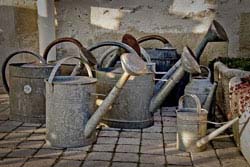Salvia Small Talk: Deep Watering vs. Sprinkling

This is the first article in a three-part series on efficient watering.
Sprinkling is the fine, misguided art of giving your landscape a quick spray of water that moistens foliage as well as soil. This can cause foliar diseases, such as mildew, while also depriving roots of sufficient water. What a perennial needs is a long gulp applied to the ground and at the edge of its canopy or drip line.
Water conservationists agree that the best way to save precious moisture in the perennial garden is to water infrequently, slowly and deeply. It is a process that strengthens plant roots by making them travel outward and downward for the drink of life. If the only water available to them is in the first few inches of soil, drought-tolerant sages won't develop the deep roots needed to thrive and to get through times of little rain.
The depth to which water needs to sink to feed the roots of a perennial depends on whether it is a new planting or well established. At first, a depth of 6 inches may be sufficient. Established shrubs may need water down to 24 to 36 inches or deeper depending on the length of their roots at maturity.
Chaparral plants, such as White Sage (Salvia apiana) and Black Sage (Salvia mellifera) are examples of deep rooting, drought-tolerant perennials that seldom need watering when established, but love an occasional drink reaching down more than 24 inches.
If you have any questions about water management of specific species of Salvias and companion plants, please contact us. We'll gladly share our knowledge. Next up in this series: How to Determine Soil Moisture Level.

 Salvia apiana
Salvia apiana
Comments
There are no comments yet.